Exploring Duong Lam Ancient Village - Handspan Travel Indochina
2Duong Lam Ancient Village is one of the long-standing villages in the northern region of Vietnam. Until now, the village has preserved the features of ancient Northern villages, including the pagoda, banyan tree, ferry, temple, etc. The artistic value here has made Duong Lam a highlight when traveling to Hanoi. Let’s explore the village with Handspan Travel Indochina!
You will find the information below in this blog post.
General information about Duong Lam Ancient Village
- Address: Son Tay Town, Hanoi
- Sightseeing fee: VND 20,000/ person
- Parking fee: VND 10,000/ person
- Bicycle rental: VND 30,000 - VND 50,000/ hour or VND 80,000 - VND 100,000/ day
Duong Lam Ancient Village is about 45 kilometers from Hanoi’s city center. You can easily come here by bus, coach, or personal vehicle or use travel agents’ services. The village has long included 9 villages belonging to Cam Gia Thinh Commune, Phuc Tho District, and Son Tay Town. Among them, Mong Phu, Dong Sang, Cam Thinh, Doai Giap, and Cam Lam are adjacent to each other. These nine villages are linked together, creating the Duong Lam Ancient Village with many customs, practices, and beliefs that have not changed for hundreds of years.
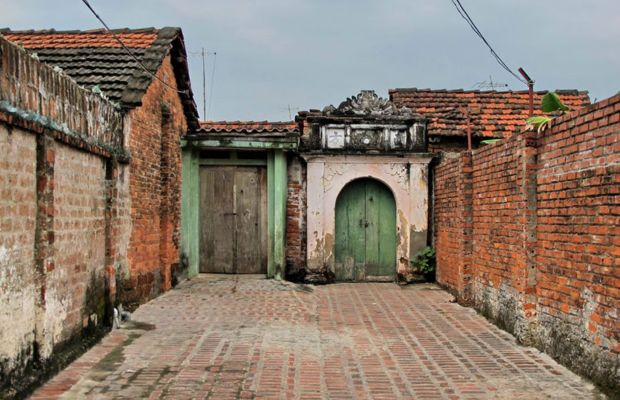
Duong Lam Ancient Village
In 2006, Duong Lam became the first ancient village in Vietnam to be recognized as a National Historical and Cultural Relic. Coming here, you will have a chance to immerse yourself in the peaceful atmosphere and admire a treasure trove of typical Vietnamese agricultural and rural lifestyles. The tangible and intangible cultural values here blend, creating the ancient space. The village gate, the village communal house, the temple, the pagoda, the well, etc., are still kept intact.
Besides cultural values and architectural beauty, Duong Lam Ancient Village is also outstanding with historical significance. It is notable for being the birthplace of two kings: Phung Hung and Ngo Quyen who played important roles in Vietnam's history.
The ideal time to visit Duong Lam Ancient Village
You can visit Duong Lam Ancient Village at any time of the year. However, the festival time and rice harvest season are the two most ideal times to visit the village. The festival time in the village takes place in the first lunar month every year. The traditional festival of Mong Phu village, which is considered the most sacred festival of the year, lasts from the 4th to the 10th. The village's Thanh Hoang ceremony is held at the oldest communal house, and it includes activities such as a palanquin procession, offering pigs and chickens, etc. After that, villagers will participate in folk games such as human chess, Chinese chess, cockfighting, etc. Visiting the village these days, you can soak in the joyful and bustling festival atmosphere.
If you cannot arrange your time to visit the village during the festival time, you can consider coming here in May and June. This is the time when the rice fields in the area are at their peak of ripeness. The roads in Duong Lam Ancient Village at this time are covered with rice and dry straw, creating a peaceful, prosperous countryside scene.
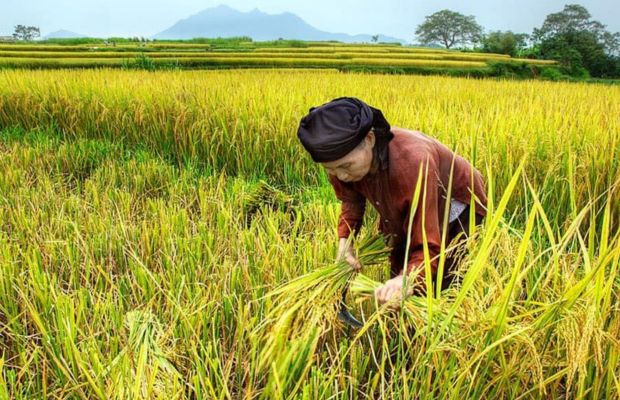
Harvesting season in Duong Lam Ancient Village
Exploring Duong Lam Ancient Village
Leaving behind the hustle and bustle of Hanoi’s city center, when coming to Duong Lam Ancient Village, you can immerse yourself in the peaceful countryside scene with fields on both sides and tall shady trees. Let’s explore some appealing spots in the ancient village of Duong Lam with us!
Duong Lam - Mong Phu Gate
Before entering Duong Lam Ancient Village, you will pass through the Mong Phu Village gate. The gate was built in 1833 with the arched architecture and laterite layer bearing the architectural culture of the Le dynasty. Next to the gate is a banyan tree over 300 years old. This scene creates a truly peaceful, ancient, and rustic landscape.
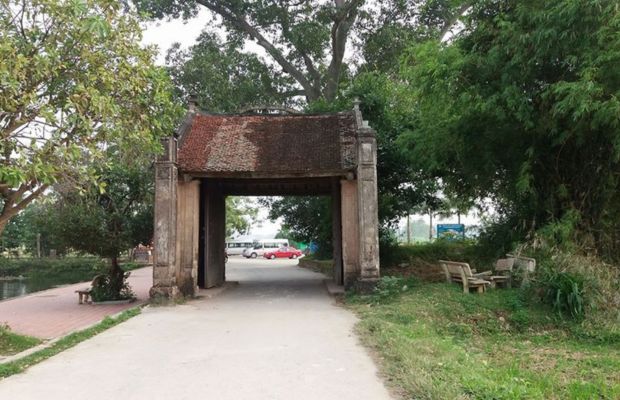
Duong Mong - Mong Phu Gate
Laterite village built next to the 300-year-old banyan tree
Next to the banyan tree is a laterite village. Walking around the village, you can see that all houses here are built from laterite. Underfoot are clean brick-paved roads, and on both sides are dark yellow laterite walls.
Mong Phu Communal House
Mong Phu Communal House is among the worth-visiting spots in Duong Lam Ancient Village. The pagoda was built nearly 400 years ago, with a total area of 1,800 square meters. The communal house’s architecture has a harmonious blend of Vietnamese-Muong architecture with stilt houses and wooden floors above the ground. This place includes Nghi Mon, a communal houseyard, Ta Mac and Huu Mac buildings on both sides and in the middle is the Dai Dinh building. Stepping inside, you will admire many ancient parallel sentences and horizontal lacquered boards dating back hundreds of years. Visiting the pagoda, besides admiring the pagoda’s architecture, you will also have a chance to learn about the unique and sophisticated sculptures inside the communal house.
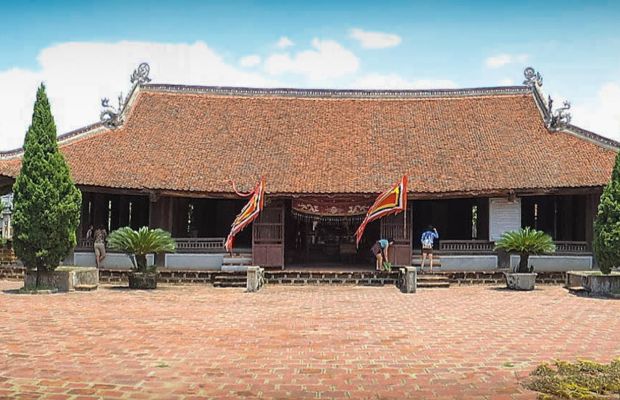
Mong Phu Communal House
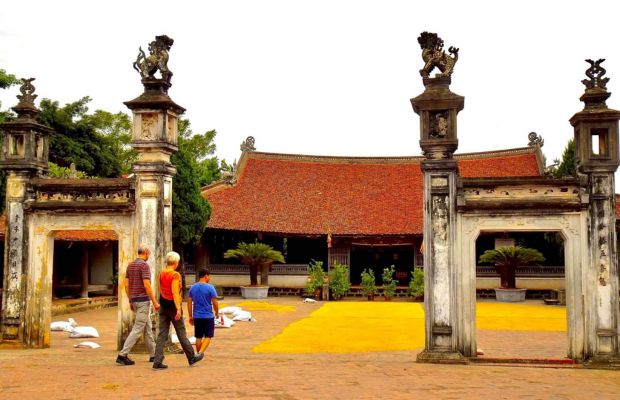
Visiting the Mong Phu Communal House
Duong Lam ancient well
Like banyan trees and communal houses, wells are also the soul of many Vietnamese villages. Coming to Duong Lam Ancient Village, you will catch up with many ancient wells. The water here is very clear and is also where people get water for daily activities. After hundreds of years, the ancient wells in Duong Lam village are still intact and extremely sturdy.
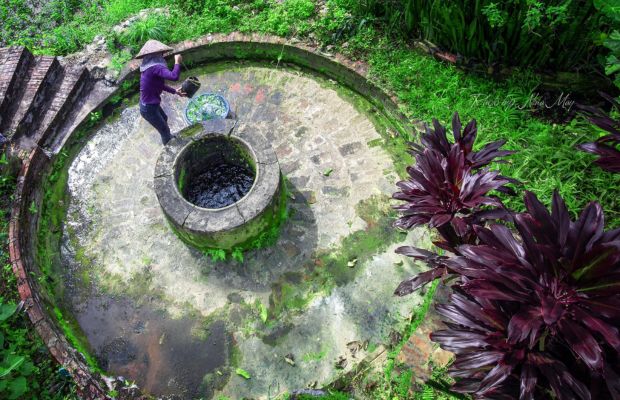
Duong Lam ancient well
Giang Van Minh Temple
Giang Van Minh Temple was built during the reign of Tu Duc King. This is a place to worship and commemorate the merits of Giang Van Minh, who made great contributions to Vietnam. Currently, it is not only a spot for sightseeing, and learning about history and culture, but also a place to educate about patriotism of Vietnamese people.
Ba Dien Ancient House
Ba Dien Ancient House has an ancient architecture dating back 200 years. The traditional house has three rooms following the ancient Northern architectural style. The altar is placed in the middle facing the door. The house’s yard has many old wine jars and flower gardens. Visiting the house, you can learn about the historical values of this house while enjoying Daly River satinash tea and Che Lam tea.
Ong Hung Ancient House
Ong Hung Ancient House is one of the most long-standing houses in Duong Lam Ancient Village. The house was built in 1649, with 12 generations of people living. It has an ancient gate built with soil, stone, rice husk residue, and mud to create an extremely unique adhesive. The house has a structure of 5 rooms, of which the 3 middle rooms are for ancestor worship, and the 2 side rooms are used as bedrooms. The house’s yard has gardens, flower beds, and typical wine jars creating a very peaceful scene.
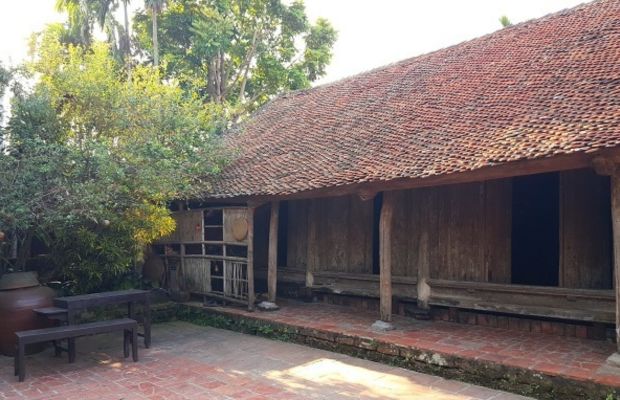
Ong Hung ancient house
Temple & Mausoleum of King Ngo Quyen
The Temple & Mausoleum of King Ngo Quyen is also an attractive spot in Duong Lam Ancient Village. This complex was built on Cam Hill. Although it has a small area, the grounds are meticulously cared for and are covered in green shade from precious trees and flowers all year round, creating a cool, harmonious, and sacred space. This is where locals and visitors commemorate the great contributions of King Ngo Quyen.
Phung Hung Temple
Phung Hung Temple was built to worship the great contributions of King Phung Hung. The Phung Hung King shrine stands on a gentle hill west of Cam Lam hamlet. Flanked by two side buildings, the shrine features a main worship hall at its front and a second, larger hall at the rear.
Ong The ancient house
Ong The ancient house has seven compartments completely joined by mortise and tenon in the traditional style, without using iron nails. Entering the house, you will smell the fragrant aroma of the jars of soy sauce arranged close together. This craft of making sauce has been passed down from generation to generation.
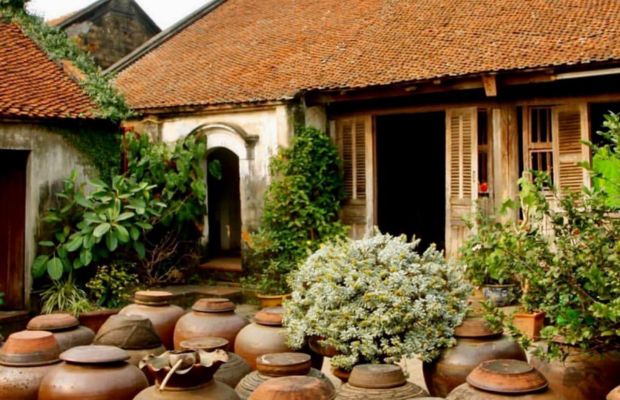
Soy sauce jars in Ong The ancient house
What to eat in Duong Lam Ancient Village?
Coming to Duong Lam Ancient Village, besides visiting and admiring ancient architectural works and exploring the unique traditional culture, you will also have a chance to try unique delicacies, imbued with the flavors of the Northern Vietnamese countryside. Below are some specialties in Duong Lam Ancient Village that you may want to try.
Sugarcane chicken
Sugarcane chicken is a type of chicken with small legs and yellow feathers, when boiled, the meat is white, and the skin is yellow and crispy. In the past, this was a precious dish only used to pay tribute to the king or during village festivals. When traveling to Duong Lam ancient village, don't forget to enjoy this specialty dish.
Roasted pork
Roasted pork is famous not only for its distinct flavor but also for its extremely unique and sophisticated preparation method. The highlight of this delicious dish is the young guava leaves that are chopped and marinated with the meat.

Roasted pork
Che kho
Che kho is made from green beans that have been steamed, then add sugar, and use large chopsticks to stir well until the beans are crushed and smooth. This dish will be more delicious when eaten cold, eating small pieces while sipping some green tea. You will feel the sweet and fragrant aroma of the dish.
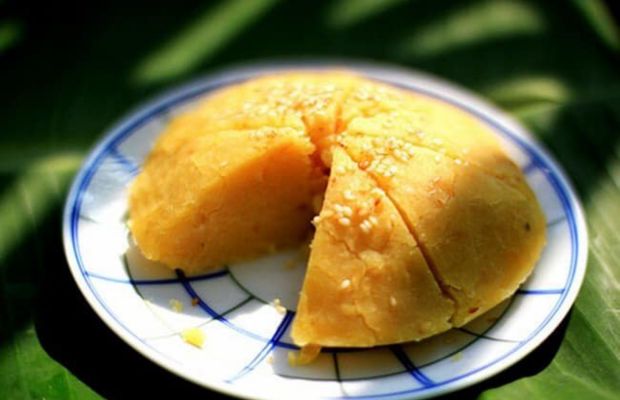
Che kho
Rice sauce
Rice sauce is a popular, rustic dish made from rice, soybeans, salt, water from the village well, etc. The sauce is used to dip vegetables, fried tofu, braised fish, braised meat, etc., for its irresistible aroma and taste.
Sesame and peanut candy
The candy made from rustic ingredients such as peanuts, sesame, sugar, malt, etc., is worth trying in Duong Lam Ancient Village. Let’s sit together, talk with local people, eat candy, and enjoy a cup of green tea!
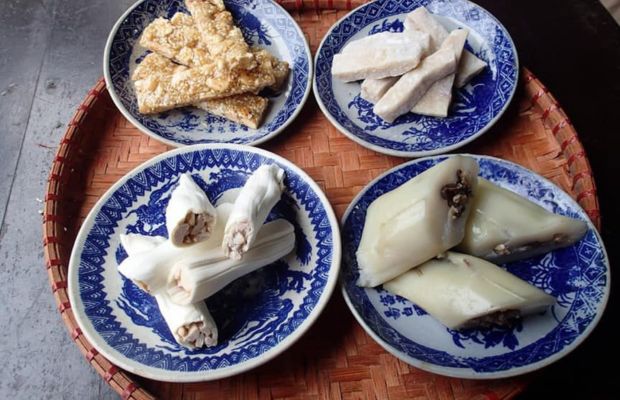
Sesame and peanut candy
Banh te
Banh te is available everywhere, but in Duong Lam Ancient Village, it has many differences compared to other regions. Here, the cake is wrapped in long, thin dong leaves, with the filling spread evenly along the leaf. When eaten, the cake has a very unique taste, chewy and fragrant.
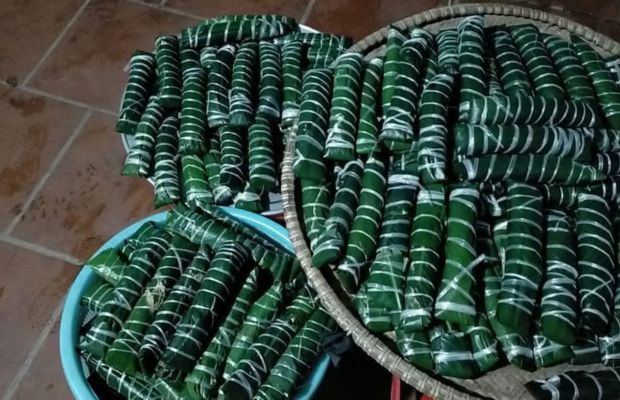
Banh te
Some tips to note when visiting Duong Lam Ancient Village
When visiting Duong Lam Ancient Village, you may want to follow these tips below for a wonderful trip.
Wearing comfortable clothes and shoes
Duong Lam Ancient Village is best explored on foot or by bike, and some of the paths can be uneven due to the age of the village. So, let’s wear comfortable clothes and sturdy shoes to easily drive in the cobbled streets and dirt paths.
Bringing water and snacks with you
While walking or cycling around the village, you may want to bring water and snacks with you. This helps you have enough energy during the trip, especially during hot weather.
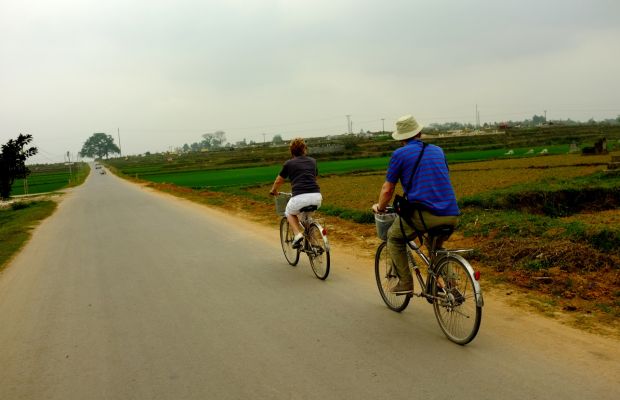
Biking in Duong Lam
Planning for half a day or more
A half-day is usually enough to explore the main sites, but if you want to truly experience the village and its peaceful atmosphere, plan for a longer visit. You can spend the morning walking around the village and enjoy lunch at a local eatery before heading back to Hanoi.
Bringing a hat, sunscreen, and insect repellent
If you’re visiting in warmer months, be prepared for the sun, as much of your time will be spent outdoors. Wear a hat, apply sunscreen, and bring insect repellent, as mosquitoes can be common in more rural areas, especially in the rainy season.
Buying local handicrafts or souvenirs
Support the local economy by purchasing traditional products like handicrafts, rice cakes, or homemade soy sauce. These make for great souvenirs and gifts. Just remember to haggle respectfully, as bargaining is common in Vietnam.
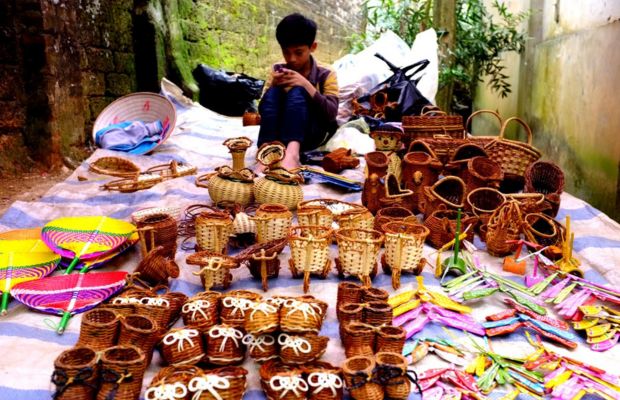
Souvenirs in Duong Lam Ancient Village
By following the above extra tips, you’ll be able to enhance your experience. This ensures both your comfort and a positive interaction with the local community.
In conclusion, you have just learned detailed information about Duong Lam Ancient Village. Hope that these pieces of information will be helpful for you. If you want to book a Duong Lam Ancient Village or Hanoi tour package or tailor your itinerary, please don’t hesitate to contact our team.
__logo.png)
__hanoi-water-puppets.jpg)
__angkor-wat-blue-reflections.jpg)
__vientiane-buddha-park-monks.jpg)
__bagan-dhammayazika-dusk.jpg)
